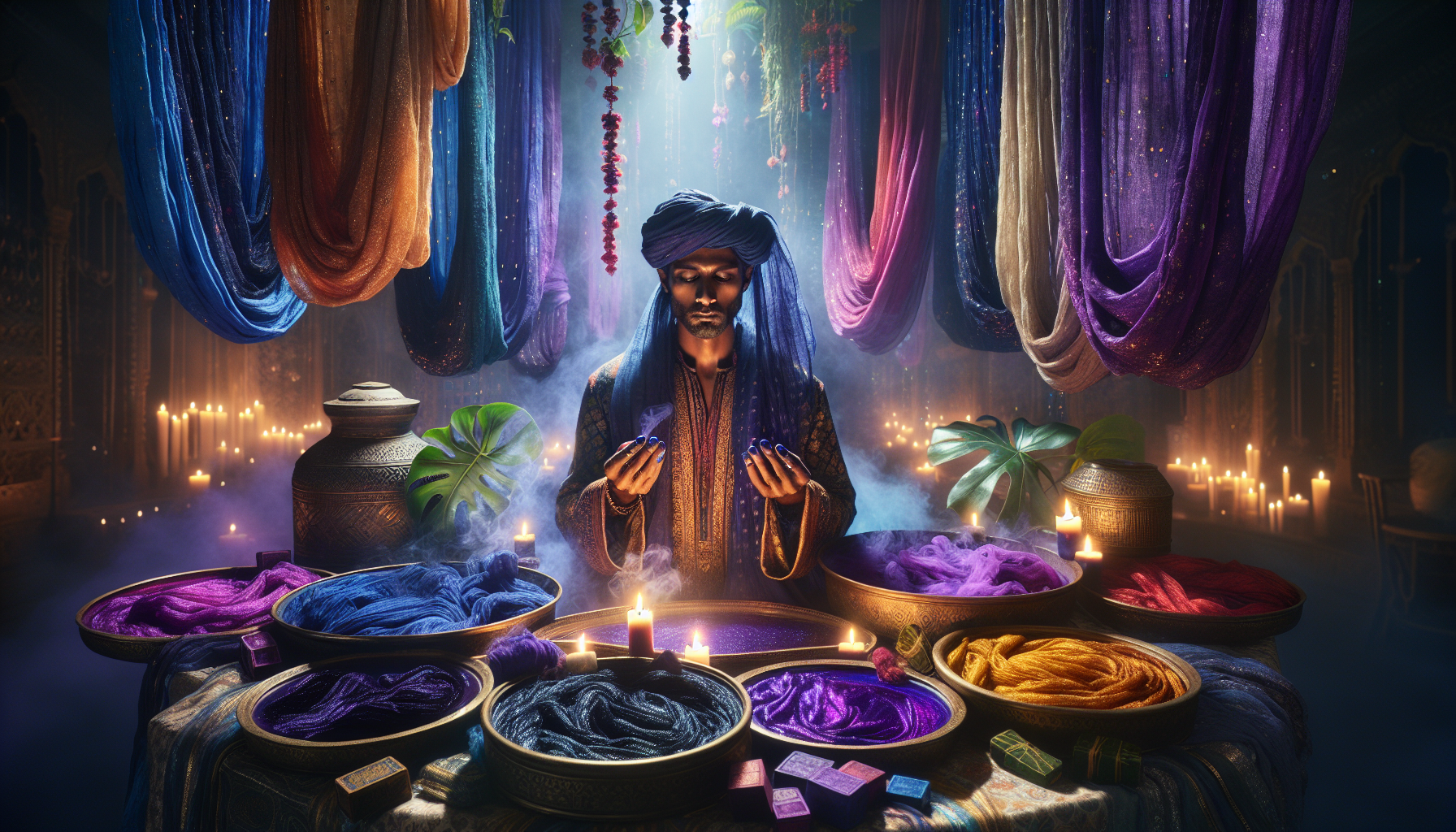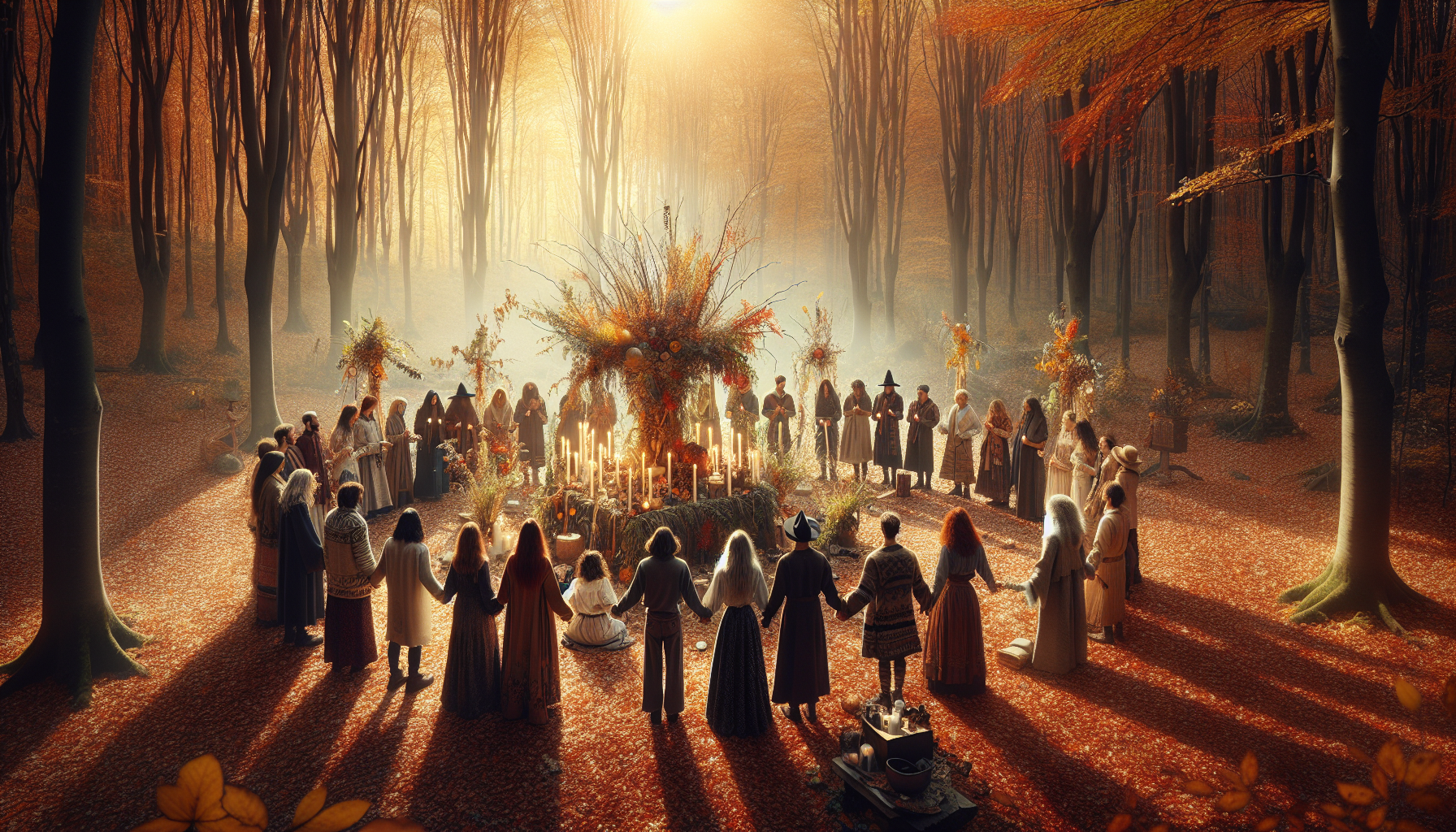In the heart of ancient civilizations, where art and spirituality intertwined seamlessly, there existed a profound reverence for colors. These weren’t just hues to embellish fabric or walls; they were vibrant expressions of life, spirituality, and identity. Today, we embark on a journey to uncover the enigmatic world of sacred dyes—pigments that held not only aesthetic value but also spiritual significance. These colors, often derived from natural sources such as plants, minerals, and insects, were believed to be imbued with mystical energies and were used in sacred rituals and ceremonies. This article delves into the fascinating history and symbolism behind these dyes, exploring how different cultures harnessed their power to communicate with the divine and express the ineffable nuances of the human spirit.
Our exploration begins with the ancient Egyptians, who were masters in the art of dyeing and revered colors as a language of the gods. Their vibrant blues, often extracted from lapis lazuli, adorned the garments of pharaohs and high priests, signifying their connection to the heavens. Meanwhile, the majestic purples of the Phoenicians, derived from the murex sea snail, were reserved for royalty, symbolizing power and divine favor. As we journey further east, the sacred saffron of India emerges as a symbol of purity and spiritual awakening, often used in religious ceremonies and to dye the robes of holy men. Each of these cultures saw sacred dyes as more than mere decoration; they were channels through which the spiritual and the physical realms converged, allowing for a deeper connection to the universe and the divine.
In addition to exploring these historical contexts, this article will delve into the modern-day resurgence of interest in sacred dyes and their applications in art and spirituality. We will examine how contemporary artists and spiritual practitioners are rediscovering these ancient pigments, infusing their work with historical richness and spiritual depth. From eco-conscious fashion designers who embrace sustainable dyeing techniques to spiritual leaders who use color to enhance meditation and healing practices, the legacy of sacred dyes continues to inspire and transform. Join us as we unlock the power of these mystical spirit codes, unveiling a world where color transcends its physical form to become a bridge to the divine. 🌿✨
Understanding Sacred Dyes: A Journey Through Time and Culture
Sacred dyes have been an integral part of human history, with their roots deeply embedded in various cultures across the globe. These natural pigments are more than just colors; they embody stories, rituals, and spiritual significance that have been passed down through generations. From the vibrant indigo blues of the ancient Mayans to the luxurious reds of the Aztecs, sacred dyes have always held a mystical allure that transcends their aesthetic appeal.
Throughout history, sacred dyes have been used for religious ceremonies, textile art, and even as a form of currency. Their significance is not only cultural but also economic. In ancient India, for instance, the production and trade of indigo dye were so valuable that it was often referred to as “blue gold.” This profound significance is echoed in other civilizations, such as the Egyptians, who used dyes in the burial cloths of their pharaohs, believing they could carry their souls to the afterlife.
Today, the exploration of sacred dyes goes beyond historical interest; it delves into their mystical properties and spiritual connections. Each dye carries a unique spirit code, believed to communicate with the wearer and the universe. These spirit codes are thought to influence emotions, alter energies, and even heal physical ailments. The following sections will explore these mystical connections, revealing how sacred dyes continue to unlock a world of spiritual possibilities.
The Mystical Properties of Sacred Dyes
The exploration of sacred dyes isn’t complete without understanding the mystical properties that have been attributed to them throughout history. Each dye is believed to carry its own energy, which can influence the aura of the person wearing it. These energies are often linked to specific chakras or spiritual centers within the body, providing a pathway to healing and enlightenment.
For example, the rich blue of indigo is associated with the third eye chakra, promoting intuition and spiritual awareness. This connection is evident in various cultures, where indigo is used in meditation and spiritual practices to enhance perception and insight. Similarly, the deep red of madder root is connected to the root chakra, grounding the individual and providing stability and strength.
Many cultures believe that sacred dyes have the power to heal. Ancient texts often mention the use of specific dyes in treating ailments or protecting against negative energies. The vibrational frequency of these dyes is thought to resonate with the body’s energy fields, restoring balance and harmony. While these claims are largely anecdotal, modern science is beginning to explore the impact of color and vibrational therapy on human health, lending some credence to these ancient beliefs.
Exploring Specific Dyes and Their Spirit Codes
- Indigo: Known for its deep blue hue, indigo is revered for its spiritual properties, often used in rituals to enhance intuition and awareness.
- Madder Root: The red color of madder root is connected to grounding energies, providing stability and strength to the wearer.
- Saffron: A sacred dye with a golden hue, saffron is linked to wisdom and prosperity, often used in religious ceremonies.
- Turmeric: With its vibrant yellow color, turmeric is associated with purification and healing, believed to cleanse both the body and spirit.
Each of these dyes carries a unique spirit code, influencing not only the wearer’s energy but also their environment. Understanding these codes can unlock new pathways to spiritual growth and personal transformation.
Applications and Uses of Sacred Dyes Today
While the historical and mystical significance of sacred dyes is fascinating, their modern applications continue to captivate artists, designers, and spiritual practitioners alike. The resurgence of interest in natural dyes is part of a larger movement towards sustainability and holistic living, as people seek to reconnect with the earth and its resources.
In the world of fashion and textiles, sacred dyes are celebrated for their rich, natural colors and environmentally friendly production methods. Unlike synthetic dyes, which can be harmful to the environment, natural dyes are biodegradable and non-toxic, making them an attractive option for eco-conscious consumers. Designers are increasingly turning to these dyes to create garments that are not only beautiful but also sustainable.
Beyond fashion, sacred dyes are also used in art and crafts, offering a unique medium for creativity and expression. Artists appreciate the subtle variations and depth of color that natural dyes provide, allowing them to create works that resonate with a sense of history and spirituality. Workshops and courses on natural dyeing techniques are becoming increasingly popular, as individuals seek to learn these ancient skills and incorporate them into their artistic practices.
Environmental and Ethical Considerations
The use of sacred dyes is not without its challenges, particularly in terms of sourcing and production. Ensuring that these dyes are harvested and produced ethically is crucial to maintaining their sustainability and cultural integrity. This involves working with local communities and respecting traditional methods of dye production.
Many organizations are dedicated to preserving the art of natural dyeing and supporting the communities that have maintained these traditions for generations. By choosing to use sacred dyes, consumers and artists can contribute to the preservation of cultural heritage and support sustainable practices.
| Dye | Color | Associated Chakra | Properties |
|---|---|---|---|
| Indigo | Blue | Third Eye | Intuition, Awareness |
| Madder Root | Red | Root | Grounding, Strength |
| Saffron | Gold | Crown | Wisdom, Prosperity |
| Turmeric | Yellow | Sacral | Purification, Healing |
Check out this YouTube video for a visual exploration of sacred dyes and their applications in modern art and fashion.
Incorporating Sacred Dyes Into Your Life
For those intrigued by the power of sacred dyes, incorporating them into your daily life can be a rewarding and transformative experience. Whether you’re looking to enhance your spiritual practices, explore new artistic mediums, or simply add a touch of natural beauty to your wardrobe, there are numerous ways to embrace the world of sacred dyes.
One of the simplest ways to start is by experimenting with natural dyeing at home. Many online resources and tutorials are available, guiding you through the process of extracting dyes from plants and applying them to fabrics. This hands-on approach not only allows you to create personalized items but also deepens your connection to the materials and their origins.
For those interested in the spiritual aspects of sacred dyes, meditation and energy work can be enhanced by wearing or using dyed items. Consider incorporating garments dyed with specific colors into your meditation practice, focusing on the energies and properties associated with each dye. This can help amplify your intentions and create a more immersive experience.
Community and Connection Through Sacred Dyes
Engaging with sacred dyes can also be a communal experience, bringing people together to share knowledge and celebrate the rich traditions behind these natural colors. Workshops and community events focused on natural dyeing provide opportunities to connect with others who share an interest in sustainable practices and cultural heritage.
By participating in these activities, you can contribute to the preservation of ancient techniques and support the artisans and communities that keep these traditions alive. Whether you’re a seasoned artist or a curious beginner, the world of sacred dyes offers endless possibilities for exploration and connection.
Join the movement and unlock the potential of sacred dyes in your life. The journey is as vibrant and diverse as the colors themselves, promising new insights and experiences at every turn.

Conclusion
In concluding our exploration of “Unlocking the Power of Sacred Dyes: Unveiling the Mystical Spirit Codes Within,” we find ourselves standing at the fascinating intersection of history, spirituality, and science. This journey has illuminated the profound connection between the natural world and human culture, a relationship vividly expressed through the medium of sacred dyes.
Throughout the article, we have delved into the origins of sacred dyes, tracing their roots back to ancient civilizations that harnessed the natural pigments found in plants, minerals, and insects. These dyes were not merely utilitarian; they were imbued with spiritual significance, used in rituals, and held as sacred objects. This historical perspective enriches our understanding of how ancient cultures viewed the world around them and the significance they placed on the colors extracted from nature.
Furthermore, we examined the spiritual and symbolic meanings attributed to these colors across different cultures. From the deep indigo of the Egyptians to the vibrant reds of the Mayans, each hue carried a unique message and was often considered a bridge to the divine. This aspect of sacred dyes underscores the universal human quest for meaning and connection with forces greater than ourselves. It highlights the timeless nature of these pursuits and how they continue to resonate in modern spiritual practices.
The article also addressed the scientific advancements that have allowed us to rediscover and preserve these ancient techniques. Modern technology, including spectroscopy and chromatography, enables us to analyze and reproduce these dyes with greater accuracy and sustainability. This fusion of ancient wisdom and modern science exemplifies the potential for innovation when we look to the past for inspiration. It also speaks to the importance of preserving cultural heritage in a rapidly changing world, ensuring that the knowledge of our ancestors is not lost to time.
Importantly, we explored the contemporary applications of sacred dyes in art, fashion, and wellness. Artists and designers are increasingly turning to natural dyes to create pieces that are not only aesthetically pleasing but also environmentally sustainable. This movement reflects a growing awareness and respect for the planet, encouraging us to live in harmony with nature rather than exploiting it. Moreover, the use of sacred dyes in holistic practices highlights their potential to enhance well-being, providing a tangible link to the spiritual traditions that revered these colors as sacred.
As we conclude, it is crucial to reinforce the significance of this topic in today’s world. The exploration of sacred dyes is not merely an academic exercise; it is a call to reconnect with the earth and our shared human heritage. In an era where technology often distances us from nature, these dyes offer a reminder of the beauty and wisdom inherent in the natural world. They invite us to slow down, to appreciate the colors around us, and to reflect on the deeper meanings they may hold.
We encourage you, dear reader, to carry the insights gained from this article into your own life. Whether you are an artist, a spiritual seeker, or someone interested in sustainable living, there is much to be learned from the power of sacred dyes. Consider how you might incorporate these natural colors into your daily life, whether through the clothes you wear, the art you create, or the spaces you inhabit. 🌿
Feel free to share this article with others who might find it inspiring or thought-provoking. By doing so, you help to keep the conversation alive and expand the community of those interested in the intersection of nature, culture, and spirituality. We also invite you to leave a comment below with your thoughts or experiences related to sacred dyes. Your perspectives and stories enrich this dialogue and deepen our collective understanding.
As we continue to explore the rich tapestry of human history and culture, let us remain curious and open to the lessons that nature has to offer. The mystical spirit codes within sacred dyes are but one example of the many wonders waiting to be uncovered. Let this journey inspire you to seek out and celebrate the sacred in all aspects of life.
Thank you for joining us on this exploration. May the colors of the world continue to inspire and illuminate your path. 🌈
Gabriel is a visual storyteller and symbolic naturalist whose creations explore the veiled ecologies and ancestral ties between humans and the living world, as echoed through myth and memory. With a sensitivity attuned to the sacred, Gabriel unveils the ancient choreography of plant, animal, and spirit — a realm where forests spoke in signs, rivers kept secrets, and every flower bore a forgotten name.
His path winds through the esoteric — tracing the rituals of forest sages, the herbal codes of ancestral healers, and the silent agreements that once guided human life in deep reciprocity with nature. From moss-covered shrines to twilight groves, Gabriel’s work reveals relationships once vital, now buried beneath layers of modern detachment.
With a foundation in visual design and the aesthetics of ancestral wisdom, Gabriel weaves storytelling into sacred ecology. His work doesn’t just depict — it channels. Drawing from myth, mysticism, and lost herbal traditions, he crafts images and narratives that pulse with the old knowing: that nature is not scenery, but kin and teacher.
Through collections of symbolic visuals, myth-rooted studies, and intuitive reflections, Gabriel invites others to rekindle forgotten senses — to listen not only with ears, but with intuition, memory, and reverence.
His work is a tribute to:
-
The mythic language of trees, stones, and roots
-
Forgotten pacts between healers and the wild
-
The sacred intelligence in nature’s unseen patterns
Whether you walk with the lore of plants, dream with the rhythms of the earth, or simply feel the call of something older in the wind through the leaves, Gabriel welcomes you into a space where symbolism, spirit, and wild nature entwine — one myth, one leaf, one vision at a time.





